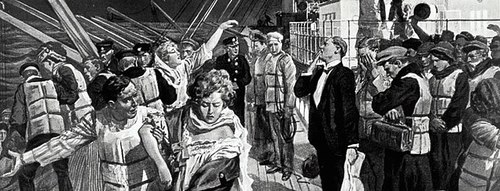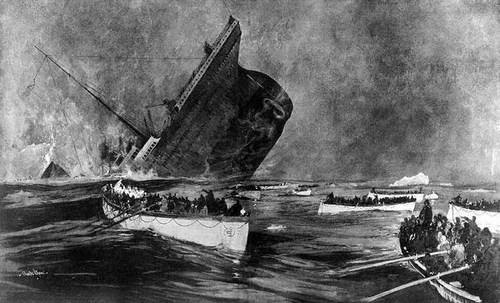Noiser
A Minute-by-Minute Breakdown of Titanic’s Sinking
Play Titanic: Ship of Dreams 1. The Biggest Ship in the World
For a ship touted as “unsinkable,” the Titanic floundered remarkably quickly. In just two hours and 40 minutes, the luxury liner was swallowed by the Atlantic. Here is a minute-by-minute breakdown of how it happened.
April 14th, 1912

11:39 PM – The Iceberg is Spotted
Lookout Fredrick Fleet sees an iceberg directly in the Titanic’s path. He rings the warning bell and calls First Officer William Murdoch on the bridge, who orders the ship to turn “hard a-starboard” and the engines reversed. The doors to the ship’s watertight compartments are closed.
11:40 PM - Impact
The Titanic’s starboard side scrapes along the side of the iceberg at high speed. Within minutes, thousands of tonnes of seawater burst through the hull, flooding six of the ship’s water-tight compartments. Designer Thomas Andrews surveys the damage and determines that Titanic will founder in about two hours.
April 15th, 1912

12:00 AM
Captain Edward Smith orders an emergency request for assistance to be broadcast to all ships within range. But the wireless operator on the nearest ship, the Californian, has gone to bed and turned off the transmitter.
12:20 AM
Captain Smith gives the order to start loading the lifeboats, knowing that the 20 emergency crafts on board will only be able to carry about half the ship’s passengers. He instructs Second Officer Charles Lightoller and First Officer William Murdoch to board women and children first. At this point, Smith realises that hundreds of people will die.
12:25 AM
The Carpathia replies to Titanic’s distress signal, but they are 58 miles away, and it will take them four hours to reach the rapidly sinking ship.
12:45 AM
The first of the lifeboats are launched, but the women-and-children-first rule and the crew’s fears that the davits wouldn’t hold mean they are only half full. Meanwhile, distress rockets are launched. The nearby Californian sees them but mistakenly thinks they are routine company signalling and ignores them.
 1:00 AM
1:00 AM
As the bow sinks lower into the water, more decks begin to flood, and water is spotted at the base of the grand staircase.
1:30 AM

With the bow now completely submerged, panic breaks out among the passengers. Several male passengers attempt to force their way onto Lifeboat 14, causing Fifth Officer Harold Lowe to fire his gun three times.
Jack Phillips, the chief wireless operator, continues to send out desperate distress calls. “Women and children in boats”, one reads, “cannot last much longer.”
2:00 AM
The bow has tilted so far into the water that the ship’s propellers are now fully visible. Crewmen desperately attempt to launch the four collapsible lifeboats. Collapsible B capsizes and is swept away.
Captain Smith finally relieves the crew of duty, saying that it is now “every man for himself.” Smith goes down with the ship, and his body is never recovered.
2:18 AM
The ship is plunged into darkness as the electricity fails and the lights go out. The bow is now completely submerged, putting incredible strain on the ship’s hull. The screech of twisting metal fills the air as the Titanic snaps in half.

2:20 AM
For a moment, the stern floats vertically, but within seconds it begins to plummet into the ocean, carrying passengers still clinging to the railings. Hundreds of people now float in the freezing water. In these temperatures, disorientation, exhaustion, and unconsciousness are likely to occur within just 15 minutes. Hypothermia and death within 45.
Even though the majority of the nearby lifeboats are only half full, most of them don’t return for fear they’ll be swamped. The few that do are too late, with most people pulled from the water dying from exposure.
2:24 AM
Both the bow and the stern reach the bottom of the Atlantic, where they remain to this day.
